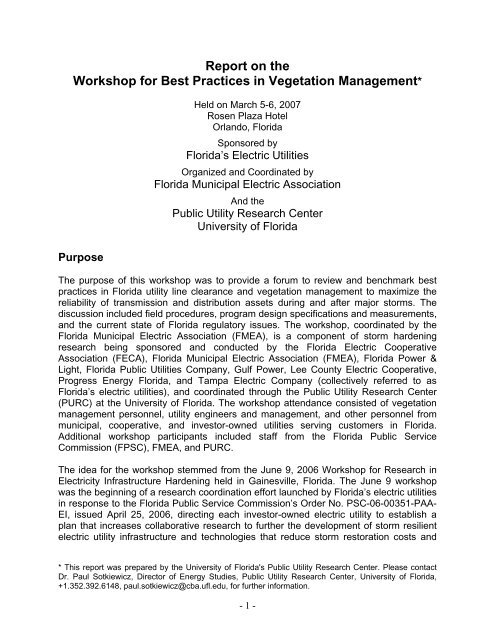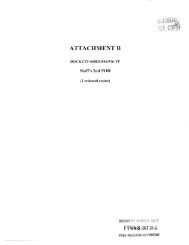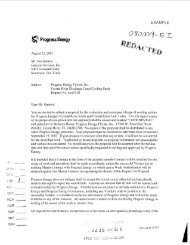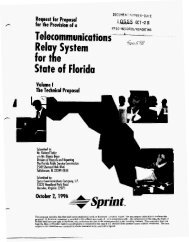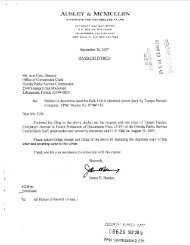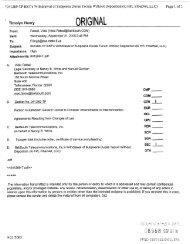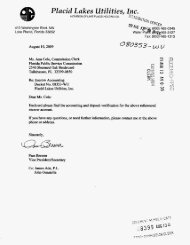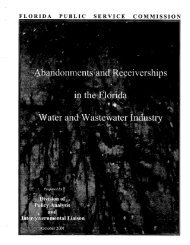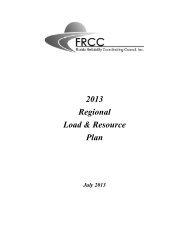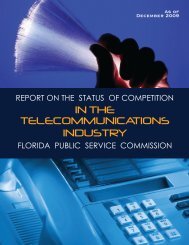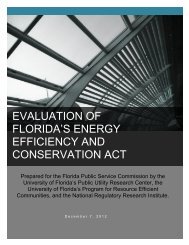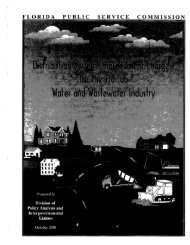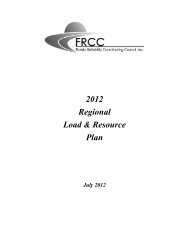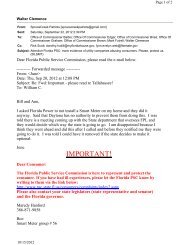Vegetation Management Workshop Report.doc - Public Service ...
Vegetation Management Workshop Report.doc - Public Service ...
Vegetation Management Workshop Report.doc - Public Service ...
You also want an ePaper? Increase the reach of your titles
YUMPU automatically turns print PDFs into web optimized ePapers that Google loves.
<strong>Report</strong> on the<br />
<strong>Workshop</strong> for Best Practices in <strong>Vegetation</strong> <strong>Management</strong>*<br />
Held on March 5-6, 2007<br />
Rosen Plaza Hotel<br />
Orlando, Florida<br />
Sponsored by<br />
Florida’s Electric Utilities<br />
Organized and Coordinated by<br />
Florida Municipal Electric Association<br />
And the<br />
<strong>Public</strong> Utility Research Center<br />
University of Florida<br />
Purpose<br />
The purpose of this workshop was to provide a forum to review and benchmark best<br />
practices in Florida utility line clearance and vegetation management to maximize the<br />
reliability of transmission and distribution assets during and after major storms. The<br />
discussion included field procedures, program design specifications and measurements,<br />
and the current state of Florida regulatory issues. The workshop, coordinated by the<br />
Florida Municipal Electric Association (FMEA), is a component of storm hardening<br />
research being sponsored and conducted by the Florida Electric Cooperative<br />
Association (FECA), Florida Municipal Electric Association (FMEA), Florida Power &<br />
Light, Florida <strong>Public</strong> Utilities Company, Gulf Power, Lee County Electric Cooperative,<br />
Progress Energy Florida, and Tampa Electric Company (collectively referred to as<br />
Florida’s electric utilities), and coordinated through the <strong>Public</strong> Utility Research Center<br />
(PURC) at the University of Florida. The workshop attendance consisted of vegetation<br />
management personnel, utility engineers and management, and other personnel from<br />
municipal, cooperative, and investor-owned utilities serving customers in Florida.<br />
Additional workshop participants included staff from the Florida <strong>Public</strong> <strong>Service</strong><br />
Commission (FPSC), FMEA, and PURC.<br />
The idea for the workshop stemmed from the June 9, 2006 <strong>Workshop</strong> for Research in<br />
Electricity Infrastructure Hardening held in Gainesville, Florida. The June 9 workshop<br />
was the beginning of a research coordination effort launched by Florida’s electric utilities<br />
in response to the Florida <strong>Public</strong> <strong>Service</strong> Commission’s Order No. PSC-06-00351-PAA-<br />
EI, issued April 25, 2006, directing each investor-owned electric utility to establish a<br />
plan that increases collaborative research to further the development of storm resilient<br />
electric utility infrastructure and technologies that reduce storm restoration costs and<br />
* This report was prepared by the University of Florida's <strong>Public</strong> Utility Research Center. Please contact<br />
Dr. Paul Sotkiewicz, Director of Energy Studies, <strong>Public</strong> Utility Research Center, University of Florida,<br />
+1.352.392.6148, paul.sotkiewicz@cba.ufl.edu, for further information.<br />
- 1 -
4/17/2007<br />
outages to customers. Following the <strong>Workshop</strong> for Research in Electricity Infrastructure<br />
Hardening, a steering committee was formed of representatives from each sponsoring<br />
utility organization to provide direction, guidance, and a work plan on the topics to be<br />
addressed by the collaborative research effort. The steering committee’s work plan is<br />
comprised of four main components: undergrounding, wind, vegetation management,<br />
and materials.<br />
The Best Practices in <strong>Vegetation</strong> <strong>Management</strong> workshop was conducted in response to<br />
the sponsoring utility organizations’ interest in vegetation management, as identified<br />
during the June 9, 2006 workshop. This report summarizes the Best Practices in<br />
<strong>Vegetation</strong> <strong>Management</strong> workshop and identifies areas of interest for further research<br />
coordination. It is organized as follows. The next two sections describe the proceedings<br />
for each day of the workshop. The last section concludes with a summary and synthesis<br />
of the dialogue and information shared at the workshop along with 10 important lessons<br />
that can be taken from the workshop. This report also contains the following<br />
appendices:<br />
Appendix A <strong>Workshop</strong> Participants<br />
Appendix B <strong>Workshop</strong> Agenda<br />
Appendix C Best Practices Identified at the <strong>Workshop</strong><br />
Appendix D Areas for Improvement Identified at the <strong>Workshop</strong><br />
Appendix E Potential <strong>Workshop</strong> Topic Ideas Identified Prior to the <strong>Workshop</strong><br />
Appendix F Discussion Questions and Responses from Break-out Groups<br />
Day One <strong>Workshop</strong> Proceedings<br />
The workshop opened with registration and an informal luncheon at noon on Monday,<br />
March 5, 2007. Mr. Barry Moline, Executive Director of FMEA, formally opened the<br />
workshop by explaining the general purpose of the steering committee, the nature of the<br />
work and research being done by the steering committee, and the impetus to hold this<br />
workshop. Mr. Moline’s presentation included information sharing about the<br />
undergrounding component of the work currently being done by the steering committee<br />
and results of Phase I of the undergrounding research. Mr. Moline also shared with the<br />
audience the impetus for the wind research sponsored by the steering committee, and<br />
the lack of understanding about actual wind speeds and wind turbulence to which trees<br />
and utility infrastructure are exposed. In sharing the work plan for vegetation<br />
management, Mr. Moline discussed why a best practices workshop was the method<br />
chosen to achieve the goal of creating a list of goals/share ideas on best practices in<br />
vegetation management towards being best prepared for future storms that may impact<br />
the state of Florida.<br />
Dr. Mark Jamison, Director of PURC, was introduced as the facilitator for the workshop.<br />
Dr. Jamison shared the mission of PURC as an international research center. He then<br />
reaffirmed the intent of the workshop: to share information and best practices and to<br />
assist the steering committee and the public in better understanding the role, process,<br />
and need for vegetation management in storm hardening electricity transmission and<br />
distribution infrastructure. Also introduced were Dr. Paul Sotkiewicz, Director of Energy<br />
- 2 -
4/17/2007<br />
Studies, PURC, who participated in discussions with registrants and helped draft this<br />
report; Ms. Megan Silbert, PURC, who served as the reporter for the workshop<br />
proceedings and helped draft this report; and Ms. Cheryl Anderson, Director of Training<br />
and Member <strong>Service</strong>s of FMEA, who was responsible for registration and coordinating<br />
workshop facilities.<br />
The floor was then opened for individual introductions. Representatives from each utility<br />
present shared with the group the following information: the name and location of the<br />
utility they represent, the size of their service territory, the number of customers served,<br />
the number of miles of distribution and transmission circuits, what storms affected them<br />
during the 2004 and 2005 hurricane seasons, and how they prepare for impending<br />
storms. A list of participants and the utilities they represent is presented in Appendix A.<br />
In their introductions, workshop registrants emphasized the desire to improve vegetation<br />
management practices and hoped the discussion and sharing of information would<br />
allow them to do so.<br />
Following the individual introductions and utility background introductions, participants<br />
shared the following information about their respective utility: a brief description of their<br />
vegetation management programs; a description of storm preparation as it relates to<br />
vegetation management; indicators of success; best practices and ideas; and areas for<br />
improvement.<br />
<strong>Vegetation</strong> management programs for transmission across transmission-owning utilities<br />
have common features as well as some variance across utilities. One common feature<br />
is the inspection and patrol of the system multiple times each year. Another common<br />
feature of these programs is the use of herbicides and trimming as needed in the rightof-way.<br />
While all transmission owning utilities maintain their systems on a cycle, the<br />
duration of the cycles has wide variability with cycles varying between two months in<br />
some areas, and up to eight years in other areas. Differences in operating environments<br />
caused by differences between rural and urban populations, or specific species of tree<br />
stands, lead to these variations in cycles.<br />
With respect to distribution, utilities trim on cycles ranging from 18 months to six years.<br />
The most common cycle is three years. Cycles may differ based on whether the circuit<br />
is a feeder or three-phase circuit (shorter time) or a lateral or single-phase circuit<br />
(longer). Some utilities use a reliability-based trimming cycle approach rather than a<br />
prescribed time cycle. Moreover, some utilities also choose to inspect and trim<br />
vegetation on a yearly basis in anticipation of hurricane season, by June 1, on circuits<br />
that serve critical infrastructure. In addition to trimming, some utilities reported the use<br />
of herbicides and tree growth retardant (TGR), while others did not. Where possible,<br />
most utilities reported trimming trees back 10 feet from the circuit in accordance with<br />
National Electrical Safety Code (NESC) standards. One utility reported only trimming<br />
back four feet from the conductor, but this required a more frequent trimming cycle of 18<br />
months. Finally, many utilities have programs that remove problem trees (diseased, fast<br />
growing, or too large) and replace them with trees that are more appropriate (healthy,<br />
slow growing, smaller) for placement near distribution facilities.<br />
- 3 -
4/17/2007<br />
Measures of success are straightforward based on the number of outages and outage<br />
reliability indices such as System Average Interruption Duration Index (SAIDI), System<br />
Average Interruption Frequency Index (SAIFI), Customer Average Interruption Duration<br />
Index (CAIDI), Customer Average Interruption Frequency Index (CAIFI), and<br />
Momentary Average Interruption Frequency Index (MAIFI).<br />
With respect to best practices, participants shared a very substantial list of ideas and<br />
practices that they believe have worked in their current programs, or would make their<br />
programs even more effective. The best practices and ideas are listed in Appendix C in<br />
the order they came up during the discussion. Prior to closing for the evening,<br />
participants were asked to indicate the two areas in the list of best practices that were<br />
most valuable to their work. The best practices and ideas chosen by participants and<br />
indicated to be of critical importance are listed below in order of importance as indicated<br />
by the number of votes, shown in parentheses, that each practice/idea received.<br />
Best Practices Ranked by Votes Received<br />
1. State law (referenced the law in California) giving utility right to trim/remove (26)<br />
2. Adequate financial resources to maintain vegetation management cycles (13)<br />
3. City partnership to work with homeowner association – city foresters understand<br />
issues (10)<br />
4. Using herbicides to control growth on vegetation and in ground (8)<br />
5. Directional pruning (7)<br />
6. Stump treatment with herbicide (7)<br />
7. Contract and bid by zones; tie to reliability indicators and share experiences<br />
among contractors (6)<br />
8. Dead and dangerous tree program – remove before cycle (5)<br />
9. Inspect priority circuits prior to storm season (5)<br />
10. Conduct public education programs about vegetation management (4)<br />
11. Inspect backbone feeders (4)<br />
12. Trade a tree and non-problematic tree programs (4)<br />
13. Maintain cycles (3)<br />
14. Moving power lines to right-of-ways (3)<br />
15. Trim circuit for critical infrastructure or critical customers (2)<br />
16. Pre-cycle maintenance towards preventable outages and inspector reviews on<br />
circuit between cycles (2)<br />
17. Notify neighborhoods before trimming (2)<br />
18. More successful with customer education and involvement (2)<br />
19. Focus on vegetation management for reliability – educate utility executives on<br />
economics (2)<br />
20. Door-to-door customer relations (2)<br />
21. Cycles vary with local conditions/neighborhoods (1)<br />
22. Training programs for contractors (1)<br />
23. Name districts responsible for maintenance (1)<br />
- 4 -
4/17/2007<br />
As was done with best practices and ideas, participants shared a list of areas where<br />
they could improve their vegetation management. The areas for improvement are listed<br />
in Appendix D in the order they came up during the discussion. Participants were asked<br />
to indicate the one item in the list of areas for improvement that would be most valuable<br />
to their work. The areas for improvement chosen by participants and indicated to be of<br />
critical importance are listed below in order of importance as indicated by the number of<br />
votes, shown in parentheses, that each practice/idea received.<br />
Areas for Improvement Ranked by Votes<br />
1. Better education of customers and public (22)<br />
2. State laws to support tree removals (18)<br />
3. Maintenance of some circuits from station to the end of the line (3)<br />
4. Access (3)<br />
5. Chemical applications (3)<br />
6. Looking at overhangs (3)<br />
7. Tree removals – support from customers (2)<br />
8. Tree trimming resources – build local workforces (1)<br />
9. Training (1)<br />
10. Reduce the number of off the right-of-way tree fall-ins (1)<br />
11. Create a new position to support reliability (1)<br />
12. Restructuring right-of-way (1)<br />
We note that some ideas or practices show up as both best practices and areas for<br />
improvement. We also note that concerns were not uniform across utilities that<br />
participated in the workshop, but varied based on utility service territory characteristics.<br />
An examination of the two lists brings out two themes quite strongly. The first theme is<br />
the need or desire to have state laws to support vegetation management efforts. The<br />
second surrounds improving education of the public and even some executives<br />
regarding vegetation management, including the improvement of customer relations<br />
regarding vegetation management.<br />
Day Two <strong>Workshop</strong> Proceedings<br />
The second day, March 6, 2007, opened with participants breaking up into their<br />
assigned discussion groups to work on identifying best practices and areas for<br />
improvement for seven topic areas: (1) Trimming Strategies; (2) Trimming around<br />
Distribution Facilities; (3) Proactive Strategies for Hazardous Trees and Damage<br />
Reduction; (4) Strategies for Working with the <strong>Public</strong> and Government; (5) Strategies for<br />
Working with the <strong>Public</strong>; (6) Operations and <strong>Management</strong>; and (7) Relations and<br />
Operations <strong>Management</strong>. The topics of the discussion were generated by the workshop<br />
registrants in advance through electronic communication from the list of topic ideas<br />
provided in Appendix E; registrants voted via email to rank the topics by importance,<br />
and the ranking was used to identify the seven major topic areas. Each topic area<br />
posited four questions for the group. Groups worked on responding to the topic areas<br />
- 5 -
4/17/2007<br />
during the morning session. The discussion group topics and respective discussion<br />
questions can be found in Appendix F.<br />
Group Discussions and Dialogue<br />
<strong>Workshop</strong> registrants participated in small roundtable discussions with members of<br />
different organizations. The discussions generated responses, shown in Appendix F to<br />
the topics also presented in Appendix F. Summation of these discussions and reports<br />
to the larger group are summarized below by topic area.<br />
Group 1: Trimming Strategies<br />
The group discussing this topic concluded that it is impractical to eliminate all treerelated<br />
outages during high-wind events since at high winds, trees will begin to fail.<br />
Trimming strategies are meant to handle day-to-day conditions. Programs are designed<br />
to handle wind speeds of 25-30 mph and afternoon thunderstorms.<br />
The group also concluded public education and communication with customers, local<br />
governments, and other stakeholders regarding the importance of vegetation<br />
management is crucial.<br />
When engaged in tree trimming, it is imperative to follow tree trimming standards such<br />
as ANSI A300 standards, to the greatest extent possible.<br />
The group examined cycle-based and reliability-based tree trimming program methods.<br />
For both methods advantages and drawbacks were cited without any conclusion as to<br />
which method was preferable. The main trade-offs between the two methods center<br />
around the ease of implementation and understanding by customers and stakeholders<br />
(cycle based) versus lower costs and more efficient use of resources (reliability based).<br />
Finally, the group pointed to the elimination of vegetation (tree limbs) hanging over lines<br />
and dead, diseased, or damaged tress as a priority. Overhang and unhealthy or dead<br />
trees have a greater chance of causing outages.<br />
Group 2: Trimming around Distribution Facilities<br />
Much like Group 1, Group 2 also concluded that it is not possible to trim trees for<br />
hurricanes, but only for everyday contingencies, and that the elimination of overhangs<br />
and subsequent tree fall-ins on lines must be a priority and goes a long way toward<br />
eliminating tree-related outages.<br />
Similar to Group 1, Group 2 cited customer education as important. In particular,<br />
customer education is needed regarding the appropriate species of trees to plant near<br />
utility distribution infrastructure, and why certain species of trees need trimming and<br />
possibly removal.<br />
- 6 -
4/17/2007<br />
Another issue that was brought to the forefront during the discussion was the need for<br />
continuity of tree trimming crews. Continuity would ensure consistent, high quality and<br />
adherence to standards in vegetation management for the utility and its customers. The<br />
group felt that recruitment and/or retention of crews whether they be utility staff or<br />
contractors is important.<br />
Finally, the discussion addressed the need to collect information regarding reliability and<br />
trimming. The focus centered on current or potential problem areas in the system as<br />
well as defining priority circuits (e.g., three-phase feeders and feeders serving critical<br />
infrastructure) that should be closely monitored.<br />
Group 3: Proactive Strategies for Hazardous Trees and Damage Reduction<br />
The group’s discussion, in addition to touching on increased inspections and removal of<br />
problem trees, focused its attention on what can be best termed as the business,<br />
organizational, and public relations side of vegetation management. Much like Groups 1<br />
and 2, this group felt that working with affected stakeholder groups and communicating<br />
with homeowners is very important.<br />
On the business side of vegetation management, the group concluded that it was<br />
imperative to have consistent and adequate financial resources to carry out the<br />
vegetation management mission. The underlying problem is that vegetation<br />
management budgets are easy to cut when the utility faces budgetary issues. So the<br />
group concluded that it is crucial to get the company board’s approval for a vegetation<br />
management program that meets well-defined specifications.<br />
The group also discussed tree trimming crews and workforce issues. In addition to<br />
specifying crew training as being important, similar to other group discussions, this<br />
group indicated that the changing workforce as it relates to vegetation management has<br />
made it increasingly difficult to find well-trained, qualified contractors and personnel.<br />
The group made the point that this may be the biggest problem facing the industry.<br />
Group 4: Strategies for Working with the <strong>Public</strong> and Government<br />
The group concluded that in working with the public and governments requires<br />
additional support from government entities and improved municipal development codes<br />
with respect to vegetation management. Part of this support can take the form of<br />
cooperation in joint efforts in communications, policy, and practices regarding<br />
vegetation management. Another area in which cooperation between government and<br />
utilities is desirable is in storm preparation and restoration. This involves working with<br />
local Emergency Operations Centers (EOCs). With respect to local ordinances, the<br />
group believes tree ordinances are appropriate.<br />
Much like the other groups, the discussion also covered communications with<br />
customers, government, and other stakeholders. One area of emphasis was sharing<br />
consequences and results from vegetation management programs. Another area of<br />
emphasis was consistency of communication and consistency in the information being<br />
- 7 -
4/17/2007<br />
disseminated while utilizing all media possible. Developing a common language or<br />
terminology using ANSI or OSHA terms was another point of emphasis. The common<br />
language can be used in developing ordinances and providing consistency in<br />
communication.<br />
Group 5: Strategies for Working with the <strong>Public</strong><br />
The group addressed the same basic topic as Group 4, but focused more on the<br />
communications aspect. The group suggested communications with the public through<br />
all forms of media from TV to radio to print media to any other interaction with the public<br />
that can get out the message about vegetation management. The message should be<br />
consistent and repetitive over time as well. The group suggested a role for the FPSC in<br />
providing public service announcements (PSAs) to help strengthen the message.<br />
Another message the group believed should be delivered is the need to improve line<br />
clearances and right-of-way widths to improve vegetation management effectiveness.<br />
The group also discussed customer worries about and misconceptions of vegetation<br />
management. The group felt that personal contact between utility staff and customers<br />
was an effective way to put customers at ease and to better inform them about options<br />
when customers refuse to allow trees to be trimmed.<br />
Group 6: Operations and <strong>Management</strong><br />
The primary focus of the discussion for this group was the role of vegetation<br />
management in storm preparation and storm response. The group identified preparation<br />
steps such as training, matching skills with the work that needs to be done, predetermining<br />
storm assignments, practicing for the real event, patrolling critical<br />
infrastructure prior to each hurricane season, having support contracts in place prior to<br />
hurricane season, and pre-staging crews to be ready for the restoration process.<br />
For the restoration process, the group identified the need to coordinate vegetation<br />
management with line work so tree crews stay ahead of line crews in the process.<br />
Moreover, the group suggested assigning a grounding crew to accompany several tree<br />
crews in case tree clearance requires lines and facilities be grounded if necessary. With<br />
regard to line crews being brought in from out of the service territory, it is suggested that<br />
pre-printed material (maps, procedures, etc) be ready for those crews and that<br />
paperwork and <strong>doc</strong>umentation for work by these crews be easy to complete.<br />
Finally, as restoration is winding down, the group expressed concern that crews may be<br />
released too soon as too quick a release may impede resuming normal trimming<br />
schedules. There is also likely tree damage that has not affected lines during the storm,<br />
but may affect lines well after the storm. Extra crews could patrol for potential danger<br />
timber and limbs and clear it before it falls into lines.<br />
- 8 -
4/17/2007<br />
Group 7: Relations and Operations <strong>Management</strong><br />
In its discussions, the group stated that utilities should further expand and develop the<br />
working relationship between the Florida Department of Transportation (FDOT) and<br />
county road departments in siting transmission and distribution facilities as well as<br />
improve on innovative engineering options to ensure line clearances.<br />
With regard to storm restoration activities, the group believes every storm has its own<br />
unique story, thus restoration needs and methods may differ by storm. Restoration<br />
should identify critical infrastructure so that it can be cleared and returned to service<br />
first. At a more detailed level, the group identified practices that have worked well or can<br />
work well such as assigning grounding crews with tree crews and issuing maps of the<br />
feeder system to tree crews so they can clear feeders first and report damage to lines in<br />
advance of line crews.<br />
In the restoration process, the group indicated that coordination between various crews<br />
working on restoration can be enhanced to ensure efficient use of restoration resources.<br />
The group also identified the need for adequate and consistent resources and<br />
supervision of those resources to ensure they are efficiently used.<br />
Finally, the group cited the need to pursue a forensic approach to discovering what has<br />
caused tree failures. Such an approach would require a designated forensic team<br />
without any other restoration responsibility that can assess why trees failed prior to<br />
clearing lines which would provide usable data to better target vegetation management<br />
resources before a storm. A standardized method of forensic analysis should be<br />
developed to better compare data across storms and utilities.<br />
Synthesis and Conclusion<br />
The group discussions on March 6 mirrored many of the areas of best practices or<br />
areas requiring improvement identified on March 5. At the top of the list as areas of both<br />
best practices and needing improvement, we find the need for laws to give utilities the<br />
legal force they require to implement effective vegetation management programs to<br />
enhance reliability. Cooperation such as this with government entities was a theme that<br />
emerged in the group discussions as well.<br />
The need for better communication and public education on vegetation management<br />
was deemed to be of significant importance in both best practices and areas for<br />
improvement. This theme also emerged as a key component for enhancing vegetation<br />
management programs and outcomes from the group discussions.<br />
Another theme that was observed in the group discussions and that was seen as a<br />
valuable best practice was the need to adequately fund vegetation management<br />
programs so that utilities can maintain their cycles and, by extension, maintain system<br />
reliability. This theme can be seen in the group discussions relating to potential cost<br />
trade-offs between cycle-based and reliability-based programs and the need to train,<br />
- 9 -
4/17/2007<br />
recruit, and retain highly qualified and skilled, preferably local if possible, tree crew<br />
personnel among other issues.<br />
Other best practices and areas for improvement were also cited with respect to specific<br />
vegetation management practices such as monitoring and patrolling facilities,<br />
eliminating tree limbs that overhang power lines, and streamlining or harmonizing<br />
logistics related to storm preparation and restoration.<br />
While there were dozens of ideas shared and dozens of best practices and areas for<br />
improvement identified, as seen in Appendices C, D, and F 10 lessons are provided<br />
below that summarize the detailed discussion during the March 5-6 workshop. These<br />
lessons are not listed in any particular order of relevance or importance as each utility<br />
faces a different situation based on the size of their customer base, location of service<br />
territory, number of circuit miles they maintain, and fraction of urban, suburban, and<br />
rural customers.<br />
(1) It is impractical to eliminate all tree-related outages during hurricanes of<br />
high-wind events. Some trees will fail at high winds, and there is no vegetation<br />
management method that can prevent this from happening.<br />
(2) Every storm has its own unique story. During 2004, hurricanes Jeanne and<br />
Frances were slow moving, albeit not as intense, storms that subjected<br />
infrastructure to a sustained pounding with heavy rains, while Wilma in 2005 was<br />
a fast moving, much higher-wind event.<br />
(3) Communication with and education for the public on all aspects of<br />
vegetation management as it relates to reliable utility operations is crucial.<br />
It is important for customers and municipalities to understand how vegetation<br />
management enhances reliability and can maintain aesthetics with the proper<br />
planning and cooperation.<br />
(4) <strong>Vegetation</strong> management programs must have access to adequate and<br />
consistent financial resources. Unfortunately, vegetation management<br />
budgets seem easy to cut as the reliability results from them may not always be<br />
immediately tangible.<br />
(5) Need for training, recruiting, and retaining highly qualified, skilled tree<br />
crews. During one group discussion, the members believed this was the biggest<br />
problem facing utility vegetation management programs.<br />
(6) Eliminate overhanging tree limbs where possible to reduce outages. The<br />
standard for line clearance is 10 feet from the line. However, branches even 10<br />
feet above the line that fall may take the line out of service, whereas branches 10<br />
feet to the side falling to the ground would likely do so harmlessly. Industry<br />
standards and codes discourage set footage clearance. Rather, species-specific<br />
and condition-specific clearance standards are promoted. Many utilities promote<br />
directional trimming which encourages growth away from lines.<br />
- 10 -
4/17/2007<br />
(7) Monitor and patrol critical distribution facilities such as major feeders and<br />
feeders that serve critical infrastructure such as hospitals, police, and<br />
fire/rescue. Many utilities report a constant monitoring and patrolling of these<br />
facilities and in some cases even trim around these facilities each year prior to<br />
hurricane season.<br />
(8) Storm preparation and restoration logistics cannot be overlooked. Utilities<br />
discussed how they prepare staging areas, line-up contractor tree crews; prepare<br />
maps and important contact information for out-of-town crews, and pair<br />
grounding, tree, and line crews together to help speed up restoration and make<br />
efficient use of the resources they have.<br />
(9) Cooperation between utilities and government at multiple levels is<br />
important. This cooperation can range from getting tree ordinances or trimming<br />
ordinances passed to coordinating with EOCs during storm preparation and<br />
restoration.<br />
(10) A dedicated tree forensic program can help provide data to make better use<br />
of resources in the future. It has been suggested that dedicated teams of<br />
foresters or arborists collect data on why trees are failing (e.g., dead, diseased,<br />
damaged already, high winds) and what species of trees are failing so as to<br />
better target vegetation management resources to enhance reliability to the<br />
extent possible during extreme wind events or afternoon thunderstorms.<br />
- 11 -
4/17/2007<br />
Appendix A: <strong>Workshop</strong> Participants<br />
Name<br />
Company/Affiliation<br />
Mr. Timothy Messick<br />
Mr. Ben Dawson<br />
Mr. John Jordan<br />
Mr. Donny Fugate<br />
Mr. Larry Tankersley<br />
Mr. Bob Bruck<br />
Mr. Bruce Kirby<br />
Mr. Perry Odom<br />
Mr. Jimmy Merritt<br />
Mr. Brent Stubstad<br />
Mr. Jason Richards<br />
Mr. Juan Amsa<br />
Mr. Bill Slaymaker<br />
Mr. John Tamsberg<br />
Mr. Daniel Q. Lee<br />
Mr. William B. McNulty<br />
Mr. Jorge Puentes<br />
Mr. Robert Brewer<br />
Mr. Tracy Maxwell<br />
Mr. Patrick Wolf<br />
Mr. Kevin Bryant<br />
Mr. Eudon Baxley<br />
Mr. Charles Nunery<br />
Mr. Steve Burns<br />
Alabama Electric Cooperative, Inc.<br />
Central Florida Electric Cooperative<br />
Central Florida Electric Cooperative<br />
Choctawhatchee Electric Cooperative<br />
Choctawhatchee Electric Cooperative<br />
City of Leesburg<br />
City of Leesburg<br />
City of Tallahassee<br />
Clay County Cooperative<br />
Escambia River Electric Cooperative<br />
Florida Keys Electric Cooperative<br />
Florida Power and Light<br />
Florida Power and Light<br />
Florida Power and Light<br />
Florida <strong>Public</strong> <strong>Service</strong> Commission<br />
Florida <strong>Public</strong> <strong>Service</strong> Commission<br />
Florida <strong>Public</strong> Utilities Company<br />
Fort Pierce Utilities Authority<br />
Gainesville Regional Utilities<br />
Gainesville Regional Utilities<br />
Glades Electric Cooperative<br />
Gulf Coast Electric Cooperative<br />
Gulf Coast Electric Cooperative<br />
Gulf Power Company<br />
- 12 -
4/17/2007<br />
Mr. Michael Robinson<br />
Mr. Robert O'Hara<br />
Mr. Jeffrey Sizemore<br />
Mr. Bruce Thompson<br />
Ms. Diana Gilman<br />
Mr. Michael Mines<br />
Ms. Sherie Burch<br />
Mr. Ernie Thomas<br />
Mr. Danny Thornton<br />
Mr. Wayne Zimmerman<br />
Mr. Van Crawford<br />
Mr. James Fones<br />
Mr. Miles Green<br />
Mr. Clay Stanphill<br />
Mr. Richard Alexander<br />
Mr. Larry G. Bonner<br />
Ms. Charlene Rubano<br />
Mr. Randall Miranda<br />
Mr. John Pinney<br />
Mr. Dennis Spellicy<br />
Dr. Mark Jamison<br />
Dr. Paul Sotkiewicz<br />
Ms. Megan Silbert<br />
Mr. Jeffrey Conaway<br />
Mr. Robert Yarbrough<br />
Mr. Kenneth Lacasse<br />
Mr. Bobby Kimbro<br />
Mr. Bernard Rowan<br />
Mr. Allen Shepard<br />
Mr. William Smith<br />
Jacksonville Electric Authority<br />
Jacksonville Electric Authority<br />
Kissimmee Utility Authority<br />
Kissimmee Utility Authority<br />
Lee County Electric Cooperative<br />
New Smyrna Beach Utilities Commission<br />
Ocala Electric Utility<br />
Okefenokee Rural Electric Membership Corp.<br />
Okefenokee Rural Electric Membership Corp.<br />
Orlando Utilities Commission<br />
Peace River Electric Cooperative, Inc.<br />
Peace River Electric Cooperative, Inc.<br />
Peace River Electric Cooperative, Inc.<br />
Peace River Electric Cooperative, Inc.<br />
Peace River Electric Cooperative, Inc.<br />
Progress Energy<br />
Progress Energy<br />
Progress Energy<br />
Progress Energy<br />
Progress Energy<br />
PURC, University of Florida<br />
PURC, University of Florida<br />
PURC, University of Florida<br />
Seminole Electric Cooperative<br />
Seminole Electric Cooperative<br />
Sumter Electric Cooperative, Inc.<br />
Talquin Electric Cooperative<br />
Talquin Electric Cooperative<br />
Talquin Electric Cooperative<br />
Talquin Electric Cooperative<br />
- 13 -
4/17/2007<br />
Mr. Luke DiRuzza<br />
Mr. Chip Turner<br />
Mr. John Webster<br />
Mr. Mark Brown<br />
Mr. Bobby Parker<br />
Mr. Marlin Sexton<br />
Tampa Electric Company<br />
Tampa Electric Company<br />
Tampa Electric Company<br />
Winter Park Electric Utility<br />
Withlacoochee River Electric Cooperative, Inc.<br />
Withlacoochee River Electric Cooperative, Inc.<br />
- 14 -
4/17/2007<br />
Appendix B: <strong>Workshop</strong> Agenda<br />
Monday, March 5<br />
Noon – 1 p.m.<br />
1 p.m. – 2:30 p.m.<br />
Lunch<br />
Introductions<br />
• 5-10 minutes per organization<br />
• Introduce representatives<br />
• Areas/Regions served<br />
• Size of utility (# of customers and miles of distribution and<br />
transmission maintained)<br />
2:30 p.m. – 3 p.m. Break<br />
Quick overview of each utility's vegetation management<br />
and storm preparedness, planning, preparation,<br />
operational methodologies, etc.<br />
• Vendors used<br />
• Crew descriptions (e.g., # of people in crews)<br />
• Types of contracts<br />
3:00 p.m. – 5:00 p.m.<br />
• Guidelines and standards<br />
• Number of storms dealt with in the past few years<br />
• Indicators of program success (e.g., outages, goals,<br />
benchmarks, cost/mile)<br />
Synthesis<br />
5 p.m. Adjourn (dinner on your own)<br />
Tuesday, March 6<br />
7:30 a.m. – 8:30 a.m. Breakfast<br />
Topic discussion on best practices in vegetation<br />
8:30 a.m. – 10:00 a.m.<br />
management<br />
• Groups work on Questions 1 and 2<br />
10:00 a.m. – 10:30 a.m. Break<br />
Topic discussion on best practices in vegetation<br />
10:30 a.m. – Noon<br />
management<br />
• Groups work on Questions 3 and 4<br />
Noon – 1 p.m.<br />
Lunch<br />
Group reports and synthesis of topic discussion on best<br />
practices in vegetation management, preparation of<br />
1 p.m. – 4 p.m.<br />
issues for report<br />
Discussion of next steps<br />
4 p.m. Adjourn – workshop concludes<br />
- 15 -
4/17/2007<br />
Appendix C: Best Practices Identified at the <strong>Workshop</strong><br />
(A number in parentheses indicates the number of votes from participants who believed<br />
it was in the top two most important best practices.)<br />
1. Maintain cycles (3)<br />
2. Adequate financial resources (13)<br />
3. Herbicide practices (8)<br />
4. Trade tree program/plant non-problematic trees (4)<br />
5. Trim at critical infrastructure for critical customers (2)<br />
6. Quality score contractors (re-do work)<br />
7. Matching replacement trees to area (relative to live) and native<br />
8. Contact customer on problem trees – cited 40% success rate<br />
9. City partnership to work with homeowner association – city foresters understand<br />
issues (10)<br />
10. State law (referenced the law in California) giving utility right to trim/remove (26)<br />
11. Contractor yearly inspection<br />
12. Tree board within the garden club – input on community sensitive trees<br />
13. Move to three-year cycle<br />
14. Take out problem trees<br />
15. Hot spot system – recognizing species growth rates<br />
16. Directional pruning (7)<br />
17. Extension service workshops or fact sheets for city foresters<br />
18. Two-year cycle for moving to right-of-way<br />
19. Guidelines for planting around lines<br />
20. Moving power lines to roadways (3)<br />
21. Vertical lines<br />
22. Stump treatment with herbicide (7)<br />
23. Dead and dangerous tree program – remove before cycle (5)<br />
24. Pre-cycle maintenance towards preventable outages and inspector reviews on<br />
circuit between cycles (2)<br />
25. Track tree outages<br />
26. Inspect priority circuits prior to storm season (5)<br />
27. Quarterly vendor meetings including safety and training<br />
28. Cycles vary with local conditions/neighborhoods (1)<br />
29. Notify neighborhoods before trimming (2)<br />
30. Auto-dater to notify about trimming<br />
31. Monitor specific problem species<br />
32. Training programs for contractors (1)<br />
33. Relationship building with local foresters and tree boards<br />
34. Match local experts with out-of-town crews<br />
35. All crews report to vegetation management issues<br />
36. Enlist the support of local experts with strong local rapport<br />
37. <strong>Public</strong> education programs (4)<br />
38. Provide better trees<br />
39. Computer models for forecasting vegetation management needs<br />
- 16 -
4/17/2007<br />
40. Inspect backbone feeders (4)<br />
41. Field visit every 20,000 CMI<br />
42. Trained staff to work with cities<br />
43. Joint work with cities<br />
44. More successful with customer education and involvement (2)<br />
45. Identify root causes of tree failure – varies by species and ground conditions<br />
46. Meet objectives rather than simply follow a rule<br />
47. Door-to-door customer relations (2)<br />
48. Cutting/chemical written permission<br />
49. Join fly-overs before a storm<br />
50. Enhanced reliability trimming – trimming back from feeders<br />
51. Focus on vegetation management for reliability – educate executives on<br />
economics (2)<br />
52. 18-month cycle with 4-6 ft. clearance – bid out with firm price per mile<br />
53. Targeted tree growth regulators<br />
54. Put easements into property titles<br />
55. Trim distribution 5-10 ft<br />
56. Inspect twice per year<br />
57. Contract and bid by zones; tie to reliability indicators and share experiences<br />
among contractors (6)<br />
58. Make cycle accountable by quarter and track by type of line<br />
59. Tree wire<br />
60. Crew coordination<br />
61. New construction underground<br />
62. Name districts responsible for maintenance (1)<br />
63. Give post-storm crews chainsaws<br />
- 17 -
4/17/2007<br />
Appendix D: Areas for Improvement Identified at the <strong>Workshop</strong><br />
(A number in parentheses indicates the number of votes from participants who believed<br />
it was the most important area for improvement.)<br />
1. Finding local assistance; decrease outsourcing<br />
2. Better education of customers and public (22)<br />
3. Tree removals – support from customers (2)<br />
4. State laws to support tree removals (18)<br />
5. Access (3)<br />
6. Develop better relationships with county management<br />
7. Reviewing outage numbers<br />
8. Revising city ordinances<br />
9. Relationship with planning department<br />
10. Restructuring right-of-way (1)<br />
11. Close calls with fires<br />
12. Inspect all circuits<br />
13. Tree trimming resources – build local workforces (1)<br />
14. Training (1)<br />
15. Road closure restrictions<br />
16. Notifications to customers of trimming schedule<br />
17. Re-clear some sections<br />
18. Buy real estate to have land rights – work closely with developers<br />
19. Better coordination with transmission department<br />
20. Better management of feeders<br />
21. Reduce the number of off the right-of-way trees (1)<br />
22. Create a new position to support reliability (1)<br />
23. Training program for contractors<br />
24. Communication<br />
25. Maintenance of some circuits from station to the end of the line (3)<br />
26. Trees falling on canopy roads – broken limbs; get contractors to identify broken<br />
limbs and remove<br />
27. Chemical applications (3)<br />
28. Looking at overhangs (3)<br />
29. Improve customer service initiatives<br />
- 18 -
4/17/2007<br />
Appendix E: Potential <strong>Workshop</strong> Topic Ideas Identified Prior to the<br />
<strong>Workshop</strong><br />
1. Clearance: how far can we go, should we go, or need to go to all but eliminate<br />
outages.<br />
2. Contractors: who to use, who to watch, share experience, do we want to<br />
endorse/recommend contractors.<br />
3. Building consistency in damage assessment to properly summarize and report a<br />
damage.<br />
4. Inspection program for hazardous trees adjacent to the right-of-ways. Pursuing<br />
permission from property owners to remove hazardous trees.<br />
5. Work with Florida Department of Transportation (FDOT) and county road<br />
departments (CRD) to provide more right-of-way for utilities so that utilities would<br />
have more clearance to vegetation on all road improvement projects and with the<br />
relocations of the utility’s lines.<br />
6. Work with county and city governments to ease the restrictions of their tree<br />
ordinances.<br />
7. Increase public awareness of the need to improve clearance and right-of-way widths<br />
for utility lines. This might be done by newspaper articles, TV, and radio ads.<br />
8. A quick overview of each utility's <strong>Vegetation</strong> <strong>Management</strong> (VM) program: # of crews,<br />
service area, # of customers, etc.<br />
9. A quick overview of each utility's storm preparedness, planning, preparation,<br />
operational methodologies, etc.<br />
10. A discussion of each utility's clearance specifications, goals for tree removal, etc.<br />
11. Clarification and or definition of terms used within the industry.<br />
12. Pro-active storm management including items such as Right Tree Right Place, tree<br />
ordinances and their impact on day-to-day operations, customer information,<br />
advertising and education, etc.<br />
13. Successful restoration partnerships with local government.<br />
14. Successful use of specialized equipment to expedite restoration.<br />
15. Strategies to managing VM resources to stay ahead of line crew needs and<br />
restoration activities. This could minimize tree crews required.<br />
16. How VM teams are organized and managed to maximize effectiveness.<br />
17. How crews are utilized/managed at different stages of restoration (initial response,<br />
systematic restoration, mop-up)<br />
18. Success stories to avoid/reduce the amount of VM damage by pro-active VM<br />
management programs, specs, communications, community support.<br />
19. How restoration strategies change from Cat 1 to Cat 5 storm.<br />
20. Developing and communicating a VM storm restoration best practices manual for<br />
crews outside of the service territory.<br />
21. Standard practices for both tree and line resources.<br />
22. Discussion on cycle-based vs. reliability-based approach to trimming - pros/cons.<br />
23. Discussion on approaches to deal with customer refusals - best practices.<br />
24. Discussion on increasing line clearing crew productivity - best practices.<br />
25. Transmission: Problems encountered and root cause.<br />
26. Transmission: NERC requirements.<br />
- 19 -
4/17/2007<br />
27. Transmission: Additional measures (clearing to legal limit of right-of-way and<br />
additional danger tree rights on adjacent property).<br />
28. Distribution: Problems encountered and root cause.<br />
29. Distribution: Trimming (observations from last hurricanes) can we adjust trimming<br />
specifications.<br />
30. Distribution: Removals – target certain species (will change based upon the part of<br />
the state that one is in); more targeted removals (species, location, obvious<br />
structural problems).<br />
31. Distribution: <strong>Public</strong> relations/ information to customers.<br />
32. Distribution: Lessons learned.<br />
33. Distribution: Day-to-day programs vis-à-vis reliability.<br />
34. Distribution: Resource allocation.<br />
35. <strong>Vegetation</strong> management program focusing on reducing vegetation related outages<br />
during normal weather, not just in the event of hurricanes.<br />
36. Improve clearance from conductors to the vegetation. Set minimum clearance<br />
specifications.<br />
37. Trim and clear vegetation from the right-of-way ground to the sky except low growing<br />
shrubs, flowers, and landscape trees.<br />
38. Danger trees in and around major feeders.<br />
39. Maintaining a scheduled right-of-way program.<br />
41. Mowing/herbicide program on the floor of your lines.<br />
42. Having a plan in place in the event of a storm.<br />
43. Danger Trees.<br />
44. Hazard Trees.<br />
45. Hot Spot work (i.e., size and scope).<br />
- 20 -
4/17/2007<br />
Appendix F: Discussion Questions and Responses from Break-out<br />
Groups<br />
Responses follow each question. Items in bold were voted upon by the larger group as<br />
most salient to the topic.<br />
Group 1: Trimming Strategies<br />
1. How far can we go, should we go, or need to go to all but eliminate outages?<br />
a. Create two lists: A list of best practices and a list of areas where utilities<br />
should look for ways to improve performance.<br />
• It is impractical to try to eliminate outages related to trees during high-wind<br />
events; at some wind speeds, the trees will fail. Trimming strategies are<br />
meant to handle day-to-day conditions. Programs are designed to handle<br />
wind of 25-30 mph and afternoon thunderstorms, not for hurricanes.<br />
• There are limitations from easements.<br />
• Best practices are latent upon maturity of program.<br />
• Most of the outages are from trees overhanging lines (cited study saying 76%<br />
of outages caused by overhang).<br />
• Target dead, diseased, or damaged trees.<br />
• Aggressive use of herbicides<br />
• <strong>Public</strong> education (cited changing practice to directional pruning – used door<br />
hangers for 1,000 customers; only received 1 call)<br />
• Proper pruning and use of ANSI 300 standards; no topping<br />
• Establish working relationships with other green agencies and industries and<br />
“sell your program” to them.<br />
2. What are the pros and cons of cycle-based trimming vs. reliability-based<br />
approach to trimming?<br />
a. Create two lists: A list of pros and cons for cycle-based trimming and a list<br />
of pros and cons for the reliability-based approach.<br />
Pros of Cycle-Based Trimming<br />
• Customer friendly and familiarity. Customers know trimming done regularly.<br />
• Easy to budget<br />
• Requires less training<br />
Cons of Cycle-Based Trimming<br />
• Too rigid<br />
• Does not consider reliability<br />
• When budgets are cut, you lose your cycle.<br />
• Differing growth rates, both species and location may not correspond to<br />
mandated cycle.<br />
• More expensive than reliability-based trimming – very high start up costs<br />
- 21 -
4/17/2007<br />
Pros of Reliability-Based Approach<br />
• More effective use of resources<br />
• Greater flexibility<br />
• Can be integrated with cycle-based<br />
• May have greater reliability<br />
• Best “bang for buck”<br />
Cons of Reliability-Based Approach<br />
• Circuits may go too long without trimming; this can influence reliability.<br />
• May become reactive-based approach when strictly followed<br />
• Can lead to higher costs (mediocre performer historically)<br />
3. What do utilities use for clearance specifications, goals for tree removal, etc.?<br />
a. Create list. Should further data be collected and distributed?<br />
Clearance specifications and goals for tree removal – further data collection<br />
• As much clearance as possible following ANSI standards<br />
• Customer restrictions<br />
• Differing growth rates, geographical and species specific<br />
• Dead, diseased, or damaged<br />
• Imminent threat to facilities<br />
• Storm related or drought weakened tree damage<br />
• Effort should always be put forth to minimizing risk.<br />
• Measure specifically or generally<br />
4. What additional measures (clearing to legal limit of right-of-way and additional<br />
danger tree rights on adjacent property) are useful for transmission facilities?<br />
a. Create list. Should further data be collected and distributed?<br />
Additional measures<br />
• Remove overhang.<br />
• Identify narrow right-of-ways and build relationships.<br />
• Maintain minimum line clearance to eliminate operations from grow-ins.<br />
• More frequent patrols<br />
• More diligence on danger trees<br />
Feedback to group 1: It is all a case-by-case basis, and the role of foresters is to<br />
minimize risk.<br />
Information gaps in group 1: N/A<br />
- 22 -
4/17/2007<br />
Group 2: Trimming around Distribution Facilities<br />
1. What were the observations from last hurricanes, and can we adjust trimming<br />
specifications?<br />
a. Create two lists: A list of best practices and a list of areas where utilities<br />
should look for ways to improve performance.<br />
Best practices of observations from last hurricanes and trimming<br />
• You cannot trim for hurricanes, only for everyday problems.<br />
• Remove trees in right-of-way, and off the right-of-way; remove hazard trees<br />
subject to legal limits.<br />
• Customer education<br />
• Ability to retain crews when hurricane is approaching; contract<br />
adjustments for utilities<br />
• Keep the same crews over time.<br />
• Restrictive time of trim before the storms?<br />
2. Should certain species be targeted for removal? How would this vary according<br />
to the areas of the state? Should removals be more targeted (e.g., by species,<br />
location, obvious structural problems)?<br />
a. Create lists of pros and cons.<br />
Pros of species-specific removal<br />
• Yes, there should be some species-specific removals.<br />
o Educate regarding specific tree species.<br />
• Removals within legal limits<br />
• Private tree companies; we assist them when the tree is too close.<br />
• Use OSHA guidelines and err on side of safety.<br />
• Customer education and specific to the utility’s role in removal<br />
3. What should be the strategies for day-to-day reliability?<br />
a. Create two lists: A list of best practices and a list of areas where utilities<br />
should look for ways to improve performance.<br />
Strategies for day-to-day reliability<br />
• Reduce overhang and subsequent fall-ins.<br />
o Where practical with access and right equipment<br />
o Target three-phase, backbone, and dual circuits.<br />
• Target hazard trees.<br />
• Differing priorities<br />
• Target tree-based lines.<br />
• Day-to-day reliability; issues of maintaining and retaining employees<br />
• Can establish pay rates to be regionally competitive.<br />
• Identify what is causing your outages.<br />
- 23 -
4/17/2007<br />
4. What should be the size and scope of hot spot work?<br />
a. Create list. Should further data be collected and distributed?<br />
Size and scope of hot spotting<br />
• Collect information from customers and line workers.<br />
• If you are going to hot spot and there is an outage, should move up in priority.<br />
• May want to bring in multiple crews; try to keep them on contract.<br />
o How many crews depends on scope of system and workload.<br />
• Reliability and dispatch operations center reports<br />
Feedback to group 2: Was there a consensus that specifications may need to be<br />
changed? (Reply): No, we cannot trim for hurricanes.<br />
Information gaps in group 2: Systematic information system for maintenance;<br />
allow more overhang removal.<br />
- 24 -
4/17/2007<br />
Group 3: Proactive Strategies for Hazardous Trees and Damage Reduction<br />
1. What are the right inspection programs for hazardous trees adjacent to the rightof-ways?<br />
How should utilities pursue permission from property owners to<br />
remove hazardous trees?<br />
a. Create two lists: A list of best practices and a list of areas where utilities<br />
should look for ways to improve performance.<br />
Best practices for inspecting hazardous trees<br />
• Communication with homeowners and internally within the utility<br />
• Consistent communication/story<br />
• Fiscal backing/consistent financial resources<br />
• Training of internal organizations<br />
o Credible decision makers who can explain “why”<br />
o Train techs and crews who make decisions<br />
• Decision needs flexibility<br />
• Trade a tree<br />
• Separate department related to right-of-way decisions (or one individual);<br />
prevents differences in different zones<br />
List of areas to look for improved performance<br />
• Documentation and development of specifications for staff of removals<br />
• All owners need to sign off (multiple owners, renters).<br />
• Train contractors (when need permission, bad tree criteria).<br />
• Where is priority level in the grand scheme of the utility especially the value<br />
for money?<br />
• Follow up on every lead. Deal with the reported problems to continue with<br />
active reporting.<br />
2. What are the success stories to avoid/reduce the amount of vegetation damage<br />
by pro-active vegetation management programs, specs, communications,<br />
community support?<br />
a. Create two lists: A list of best practices and a list of areas where utilities<br />
should look for ways to improve performance.<br />
Best practices for reducing/avoiding amount of vegetation damage<br />
• Training of staff plus a credible person in charge of the program<br />
• Document everything – reasons targeting tree, customer communication.<br />
• Have company board approve the defined specs. Get technical basis<br />
first.<br />
• Get buy-in from constituents proactively (neighborhood associations, garden<br />
clubs).<br />
• Adequate funding for programs<br />
• Inspection and correction on feeders<br />
- 25 -
4/17/2007<br />
Areas for improvement for reducing/avoiding amount of vegetation damage<br />
• Proactive and preventative vegetation management<br />
• Clear information and direction from FPSC<br />
• Funding for programs<br />
• Aggressive removal of problem trees<br />
• Increased inspections<br />
3. Contractors: Who to use and who to watch? What have been the experiences<br />
with various contractors? What are the endorsements and recommendations, if<br />
appropriate?<br />
a. Create list. Should further data be collected and distributed?<br />
Contractors and further information to be collected<br />
• Look at the people working in the company not the company name<br />
• Need experience as high requirement<br />
• Boy Scout – honest, trustworthy, fair<br />
• Trained in what they are doing<br />
• Local knowledge of your system<br />
• Good safety record and actively push safety program<br />
• Balance of senior and apprentice<br />
• Changing workforce has become a problem in finding qualified<br />
contractors; tough to find local help.<br />
4. What are the standard practices for both tree and line resources?<br />
a. Create two lists: A list of best practices and a list of areas where utilities<br />
should look for ways to improve performance.<br />
Best practices in standard practices for both tree and line resources<br />
• Standards will differ – site specific problems: historical, rural, urban and will<br />
differ by utility.<br />
• Standards should include a clear discussion between the contractor and the<br />
utility.<br />
• Move the lines to accessible areas (i.e., front lot vs. back lot lines).<br />
Feedback to group 3: There is a limit to how long you can work a tree worker<br />
Information gaps in group 3: Finding competent people to do the work is the<br />
biggest challenge facing this industry; involve outside researchers to add<br />
credibility to this work. Examples were University of Florida’s Institute of Food<br />
and Agricultural Sciences (IFAS) fact sheets.<br />
- 26 -
4/17/2007<br />
Group 4: Strategies for Working with the <strong>Public</strong> and Government<br />
1. What are the appropriate pro-active storm management policies such as Right<br />
Tree Right Place, tree ordinances and their impact on day-to-day operations,<br />
customer information, advertising, and education, etc?<br />
a. Create two lists: A list of best practices and a list of areas where utilities<br />
should look for ways to improve performance.<br />
2. What are the appropriate strategies for working with county and city governments<br />
to ease the restrictions of their tree ordinances?<br />
a. Create two lists: A list of best practices and a list of areas where utilities<br />
should look for ways to improve performance.<br />
Best practices in pro-active storm management policies and working with county<br />
and city governments<br />
• Have an impact on municipal development codes by working closely<br />
with cities and local developer groups on planting issues.<br />
• Support from government entities for trimming and removals<br />
• Consistency<br />
• Involvement of all groups<br />
Areas for improvement in pro-active storm management policies<br />
• Communication<br />
• Reaching all the groups<br />
• Consistency of the information<br />
• Effort to implement consistency of information – have customer relations get<br />
the message out.<br />
Areas for improvement for working with county and city governments<br />
• Utilize proactive media outlets to educate consumers.<br />
• More restrictive easements with remedies (legally binding)<br />
• Share consequences and results of vegetation management.<br />
3. Can the industry clarify and/or provide definitions of terms used within the<br />
industry?<br />
a. Suggest strategies; pros and cons<br />
Strategies, pros and cons of the industry clarifying and/or providing definitions of<br />
industry-specific terms<br />
• Use ANSI and OSHA terms.<br />
• Use terms according to arboriculture standards.<br />
• Identify terms within ordinances.<br />
• Identify codes within municipalities and eliminate inconsistent language.<br />
• Define what is abuse and what is not abuse--define proper trimming.<br />
• Include government, cities, landscapers in discussion and decision making<br />
process.<br />
• Advantages of undertaking the above points include consistency and<br />
inclusion of all groups in the process.<br />
- 27 -
4/17/2007<br />
• The drawback of the above points is the effort required to implement<br />
communication and consistency.<br />
4. What have been the successful restoration partnerships with local governments?<br />
a. Create two lists: A list of best practices and a list of areas where utilities<br />
should look for ways to improve performance.<br />
Best practices in successful restoration partnerships with local governments<br />
• Barricading and blocking roads<br />
• Staging equipment utilizing resources<br />
• Clearing roads for access<br />
• Mock storm preparation with EOC and planners<br />
• Communication with residents – even without power, can use radio<br />
Areas for improvement in successful restoration partnerships with local<br />
governments<br />
• More joint effort in getting the message out, policies, and practices<br />
• More preplanning<br />
• Prearranging clean-up efforts<br />
• Consistency of actions/plans of action among utilities<br />
Feedback to group 4: N/A<br />
Information gaps in group 4: More emphasis on EOC coordination/liaison<br />
- 28 -
4/17/2007<br />
Group 5: Strategies for Working with the <strong>Public</strong><br />
1. What are the best ways to increase public awareness of the need to improve<br />
clearance and right-of-way widths for utility lines: newspaper articles, TV, and<br />
radio ads?<br />
a. Create two lists: A list of best practices and a list of areas where utilities<br />
should look for ways to improve performance.<br />
Best practices to increase public awareness of the need to improve clearance<br />
and right-of-way widths for utility lines<br />
• TV/<strong>Public</strong> TV<br />
• Civic associations<br />
• Demonstrations and expositions<br />
• Planting guides<br />
• Home owners’ associations (HOAs)<br />
• Websites<br />
• Bill stuffers<br />
• Personal contact<br />
• EOC local government<br />
• Brochures<br />
• Re-entry plans<br />
• Target child safety awareness<br />
Areas of improvement to increase public awareness of the need to improve<br />
clearance and right-of-way widths for utility lines<br />
• Working with the Department of Community Affairs (DCA) to help control and<br />
provide guidance to local ordinances<br />
• Local tree ordinances that prohibit planting trees under lines<br />
• Demonstration and placards at “do-it-yourself” (DIY) stores<br />
• Participate in nursery shows and associations – teach the folks who sell to the<br />
public.<br />
• PSC can give strength in improving the understanding.<br />
o PSAs from PSC<br />
2. What are the best approaches to deal with customer refusals?<br />
a. Create two lists: A list of best practices and a list of areas where utilities<br />
should look for ways to improve performance.<br />
Best practices to deal with customer refusals<br />
• Personal contact to explain the ramifications of not trimming, explain the local<br />
trade a tree program, or even bartering with a customer to trim beyond<br />
requirements.<br />
• Barter with the customer to go beyond may depend on the type of crew doing<br />
the work (hourly vs. piece work).<br />
• Reconfigure the line at the utility’s cost.<br />
• Reconfigure the line and pass the cost to the customer.<br />
• Peer pressure with neighbors<br />
- 29 -
4/17/2007<br />
• Install isolating devices so the rest of the line will not be affected.<br />
• Easement enforcement<br />
Areas of improvement to deal with customer refusals<br />
• Training in public relations for employees and contractors doing this work<br />
• Bridge language gap.<br />
• Offer gift card rather than replanting – also lower cost.<br />
• Target child education so that information is passed to parents.<br />
3. What are the best approaches for keeping the public informed?<br />
a. Create two lists: A list of best practices and a list of areas where utilities<br />
should look for ways to improve performance.<br />
Best practices for keeping public informed<br />
• (Most overlap with question 1 answered by this group.)<br />
• Keep public informed.<br />
• Information, information, information<br />
• Local news<br />
• Consistency and repetitiveness<br />
Areas of improvement for keeping public informed<br />
• PSC with regular PSA campaigns<br />
• Local news media getting out information on hurricane preparedness –<br />
embedded with the annual announcements<br />
• Messages must be consistent and repetitive.<br />
4. What are the public’s biggest worries? Biggest misconceptions?<br />
a. Create list. Should further data be collected and distributed?<br />
Biggest Worries<br />
• Loss of power<br />
• Aesthetics: trees will be “butchered” or removed<br />
• Property devaluation<br />
Biggest concerns from public – misconceptions<br />
• Do not understand the clearance requirements and why<br />
• No idea what the trimming costs are<br />
• Power company does not like trees<br />
• Do not understand the impact on other customers<br />
• Safety issues<br />
• What undergrounding actually entails and that it may not solve the problem<br />
- 30 -
4/17/2007<br />
This group also stated that further data should be collected and distributed.<br />
• Examples of problems and solutions should be recorded and reported.<br />
• Continuous communication between utilities and between utilities and<br />
customers is necessary.<br />
Feedback to group 5: N/A<br />
Information gaps in group 5: Re-entry plans<br />
- 31 -
4/17/2007<br />
Group 6: Operations and <strong>Management</strong><br />
1. How should vegetation management teams be organized and managed to<br />
maximize effectiveness?<br />
a. Create two lists: A list of best practices and a list of areas where utilities<br />
should look for ways to improve performance.<br />
Best practices to organize vegetation management<br />
• Develop pre-determine storm assignments.<br />
• Practice the plan/dry run the procedures.<br />
• Patrol CIF (critical infrastructure facility) feeders by June 1. Joint patrol<br />
between service planners and vegetation management persons<br />
• Have support contracts in place (i.e., port-o-lets, helicopters, staging sites,<br />
tree crews, line crews).<br />
• Bring in grounding crews to work with tree crews. 1 grounding crew to 6 tree<br />
crews.<br />
• Coordinate vegetation management with line work to stay ahead of the line<br />
work.<br />
• Pre-staging crews; include training and safety.<br />
Areas of improvement to organize vegetation management<br />
• Good supervision of the tree crews (1 GM manager per 6 crews suggested)<br />
• VMCCR – vegetation management contract compliance representative per 50<br />
tree resources<br />
• Matching the skill with the work that needs to be done (i.e., bucket versus<br />
climber) Climbing skills needed especially for grounding crews.<br />
• Clear expectations<br />
• Train and plan in advance. Utilize manuals, job aides with pictures.<br />
• Use local support – meter readers, etc to get some of the out-of-town crews<br />
familiar with the area.<br />
• Preprinted materials for crews coming from out-of-town<br />
o Simple to understand and use time sheets for contractors<br />
2. What are the best ways for developing and communicating a vegetation<br />
management storm restoration best practices manual for foreign crews?<br />
a. Create two lists: A list of best practices and a list of areas where utilities<br />
should look for ways to improve performance.<br />
Best practices for developing and communicating a vegetation management<br />
restoration program<br />
• Overlap from above<br />
Areas of improvement for developing and communicating a vegetation<br />
management restoration program<br />
• Overlap from above<br />
• Utilize manuals, video, and pictures that are bilingual.<br />
- 32 -
4/17/2007<br />
• For pre-printed material, vegetation management standards should be<br />
stressed especially trim standards, brush policy, and safety procedures.<br />
• Share contact information with utility workers – local resources for outof-town<br />
workers (hospitals, police and fire dispatch, utility control room<br />
dispatch, etc).<br />
3. How crews are utilized/managed at different stages of restoration? How they are<br />
best made productive?<br />
a. Create list. Should further data be collected and distributed?<br />
List of how crews are utilized/managed during restoration<br />
• Initial response: Pre-staged based on forecast models<br />
o Link tree crews to line crews.<br />
o Have crews work together.<br />
o Pre-stage crews based on forecast models.<br />
o Have one vegetation crew with every two line crews.<br />
o Be ready to use the tree crews upon arrival – have maps, etc.<br />
o Utilize the meter readers and local folks to get the crews out and<br />
survey damage.<br />
• Systematic Restoration<br />
o Coordinate vegetation management and line crew restoration plan.<br />
o Pull away from the linked crews.<br />
o Have daily meetings with the restoration personnel.<br />
o Allow vegetation management to stay ahead of crews.<br />
o Planner per 50 tree resources; keep focus.<br />
• Mop-up<br />
o Conduct sweeps and patrols for danger timber that may fall into lines<br />
well after the storm.<br />
o CCRs or patrol people ride out the line.<br />
o Identify locations on maps and then have tree crews resolve.<br />
o Make sure the crews stay long enough for the mop-up and lower<br />
priority work; do not release your resources too early in order to get<br />
back to normal work schedules as quickly as possible.<br />
4. How to develop a plan in case of a storm? How do restoration strategies change<br />
from Cat 1 to Cat 5 storm?<br />
a. Create list. Should further data be collected and distributed?<br />
(Did not have time to answer the 4 th question)<br />
Feedback to group 6: Do we seem to be losing tree climbers to bucket<br />
operators? Do we have crews we cannot use?<br />
Yes, we have a generation of bucket babies, and no one knows how to fly<br />
anymore.<br />
Documentation for reimbursement is very complicated.<br />
- 33 -
4/17/2007<br />
Information gaps in group 6: Maintaining line under normal cost standards – once<br />
you release the crew, you are then financially responsible. Timing-wise, there is<br />
an initial rapid die down after the storm. The ability of utilities to charge to the<br />
storm – where is the line and what does this entail. This needs more clarity,<br />
especially at the appeal level (discussion centered on damage from storm<br />
whereby the line is still in service, but is damaged and will fail in the long run).<br />
- 34 -
4/17/2007<br />
Group 7: Relations and Operations <strong>Management</strong><br />
1. How should utilities work with the Florida Department of Transportation<br />
(FDOT) and county road departments (CRD) to provide more right-of-way for<br />
utilities so that you would have more clearance to vegetation on all road<br />
improvement projects and with the relocations of the utility’s lines?<br />
a. Create two lists: A list of best practices and a list of areas where utilities<br />
should look for ways to improve performance.<br />
Referred to the manual, large manual that does not necessarily address<br />
concerns where part of the vegetation is on private property<br />
• Continue to further expand and develop our working relationship with FDOT<br />
and CRD on both transmission and distribution.<br />
• Improve on innovative engineering options (i.e., re-routing, tree wire) and<br />
permanent line clearance.<br />
• Temporary construction easements from FDOT - can it be declared a<br />
permanent line or maintenance easement.<br />
2. What strategies are best for managing vegetation management resources to stay<br />
ahead of line crew needs and restoration activities? This could minimize tree<br />
crews required?<br />
a. Create two lists: A list of best practices and a list of areas where utilities<br />
should look for ways to improve performance.<br />
Best practices for managing vegetation management resources to stay ahead of<br />
line crew needs and restoration activities<br />
• Every storm has a unique story.<br />
• Transmission and distribution methods differ based upon the storm (i.e.,<br />
storm that sits in one place).<br />
o Overall for transmission, they could plot and get a better feel for what<br />
may be impacted.<br />
o At distribution level, more of an issue of geography<br />
• If inspections are not complete following a storm<br />
o Issue feeder maps to tree crews to clear the backbone first where<br />
crews can also report on damage in advance of line crews.<br />
o If line crews are available, match tree crews with line crews or keep the<br />
tree crews ahead of the line crews.<br />
- Make these decisions locally and predicated on type of storm.<br />
o As inspections are more complete, reallocate tree crew/line crew mix.<br />
o Plan for grounding crews to accompany tree crews for some clearance<br />
operations.<br />
o Many times this methodology is predicated on the storm.<br />
• Identify critical infrastructure and clear and return it to service first.<br />
o Do easiest work first.<br />
o Outside-in methodology<br />
- 35 -
4/17/2007<br />
Areas of improvement for managing vegetation management resources to stay<br />
ahead of line crew needs and restoration activities<br />
• Better coordination and communication about persons working<br />
o Examine details of your overall storm plan at each individual utility.<br />
o Verbal and/or signage<br />
3. How can a scheduled right-of-way program be maintained?<br />
a. Create list. Should further data be collected and distributed?<br />
• Adequate and consistent resources and supervision<br />
o Information tools and database management<br />
• Funding qualified, available crews and tree resources<br />
4. How can a utility build consistency in damage assessment to properly summarize<br />
and report damage?<br />
a. Create list. Should further data be collected and distributed?<br />
For distribution, pursue a forensic approach to discovering what caused<br />
the failure<br />
• Dedicated forensic team<br />
• Diagnose reasons for tree failure in advance of tree crews clearing lines.<br />
• Needs to happen during the restoration for distribution<br />
• Need useable data.<br />
For transmission, more of an after storm forensic review<br />
• When a tree causes problems in a storm, do a forensic analysis of the tree.<br />
o Need to be identified before the storm, have a programmed approach<br />
and should be part of overall forensic team; not a part of the storm<br />
recovery responsibility.<br />
Feedback to group 7: Regarding forensics on distribution, look at the trees prestorm<br />
– were they healthy, diseased, etc?<br />
Discussion from a registrant about forensics; another question posed about what<br />
would be the use of the data?<br />
Discussion of trade-offs to collecting and using the data.<br />
Discussion of damage assessments versus forensics; utilities should be sharing<br />
information and completing the full task of restoration. There should be more<br />
standardized methodology for forensics.<br />
Information gaps in group 7: Temporary construction easements from FDOT -<br />
can it be declared a permanent line or maintenance easement?<br />
- 36 -
4/17/2007<br />
Unassigned Issues and Topics (In case of extra time)<br />
1. What have been the successful uses of specialized equipment to expedite<br />
restoration?<br />
a. Lease equipment from logging companies<br />
b. Marsh masters<br />
2. What are the problems encountered in transmission and what are the root<br />
causes? In distribution?<br />
a. Relating it to restoration<br />
b. Piling debris in the wrong places by others, especially with undergrounding<br />
3. What are the lessons learned in distribution?<br />
a. Right person at the EOC who can speak “both languages”<br />
b. Maintain clearances<br />
4. What are the lessons learned in resource allocation?<br />
a. Neutral monitoring association – almost like an air traffic controller<br />
b. Configuration state wide – what if a storm or storms hit in many areas<br />
Feedback: EOC provided a lot of resources post-Hurricane Ivan<br />
Information gaps: N/A<br />
- 37 -


